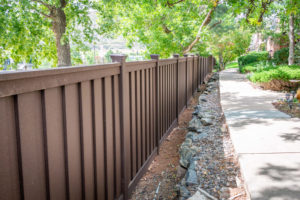 Suburban neighborhoods can occasionally be home to something no one wants to deal with: disputes between neighbors. When homes are close together and share fence lines, the neighbors will eventually have to address building a fence, or repairing an existing fence between the properties.
Suburban neighborhoods can occasionally be home to something no one wants to deal with: disputes between neighbors. When homes are close together and share fence lines, the neighbors will eventually have to address building a fence, or repairing an existing fence between the properties.
If executed in a well-thought-out manner, this process can go smoothly for the homeowners and the contractor. But there are some nuances to how a fence project between neighbors should play out for the best outcome. Do good fences make good neighbors, or do good neighbors make good fences?
Sharing a Fence Project with Your Neighbor: Are You on the Same Page?
Prior to contacting a fencing contractor for a shared fence, neighbors should get together and decide upon how they will be paying for the fence. Will the cost be split evenly, or will one homeowner be paying more? You will also want to confirm that both parties agree that the fence will be built directly on the property line. This is the best practice when it comes to building a shared fence.
Other project elements neighbors should agree upon include the fencing material and style, as well as removal of any debris or trees and bushes along the fence line. Ideally, the homeowners will work together to clear debris and obstructions from the fence line. Or, if there’s a large tree in the way that both neighbors want to keep, the plan can include boxing around that tree trunk.
Lastly, you will want to discuss with your neighbor who will maintain the fence in the future. A great option is to choose Trex fencing, which doesn’t require maintenance.
You might consider putting the fence project (including placement and material type) and payment plan down in writing and having documentation that both homeowners agree to pay their portion.
How a Fencing Contractor Works with Two Homeowners
Even if only one homeowner contacts the fencing contractor to start the project, if the parties are splitting the cost of the fence the contractor will want to have the contact information for the other homeowner as well. The contractor will then provide their proposal or quote to each homeowner so that it’s clear where each payment is coming from. This is not only the best way to prevent miscommunication and disputes, it’s also the more legal route for protection. It is clear to the contractor who the responsible parties are.
This process is helpful for clear communication as well. The fencing contractor can consult both neighbors before construction day to ensure there are no issues, surprises, or road blocks to the project. They will ensure each neighbor can plan to have kids or pets corralled before construction day.
To be clear, if only one neighbor wants to receive the proposal from the contractor, and then deal with their neighbor themselves, they are 100% financially responsible for the cost of the agreed upon project.
Related post: 5 Things to Know Before You Add, Repair, or Replace a Fence
Identifying Property Boundaries for a Fence Between Neighbors
A good rule of thumb to follow for fence placement is: if both neighbors share in the cost of the fence, the fence can be built on the property line, splitting the two properties. If one property is paying for the fence, it should be built six inches inside the property line. This ensures the fence is well within the property line and helps avoid disputes later, especially if the neighbors change over.
Once property lines have been identified and verified by the homeowner through their county assessor’s or city office, your fencing contractor will plan the fence placement. At Integrity Fencing, our proposals show a Google aerial view and an AutoCAD layout on top of the Google view. This shows both parties exactly where we plan on installing the fence.
If there is question about the accuracy of the plot plans, a foolproof way to identify property lines is to call in an Improvement Location Certificate (ILC) survey. This will give you all the accurate, and legal, property pin corners, which are needed to lay down fencing. There is a cost associated with this service, but not as much as a full-on land survey.
What Fence Type is Best for a Shared Fence?

A good fence between neighbors has alternating panels which give both neighbors the equal amount of finished and unfinished panels. Unfinished simply means the side that shows the framing. Overlapping pickets are a great option for complete privacy. The placement of overlapping pickets takes into account that pickets shrink once they are installed so they are generally overlapped by one inch on each side. This provides a nice-looking fence overall, similar to the Trex Seclusion style.
Good Neighbors Make Good Fences
As with many things in life, over communicating to ensure clarity is almost always going to be beneficial. When it comes to something like a shared fence that involves two properties and two homeowners, it’s important that all of the expectations are clear from the beginning, to avoid misunderstanding or disputes. If you’re splitting the cost of a shared fence with your neighbor, ensure everything is clear to all parties involved, including the fencing contractor.
